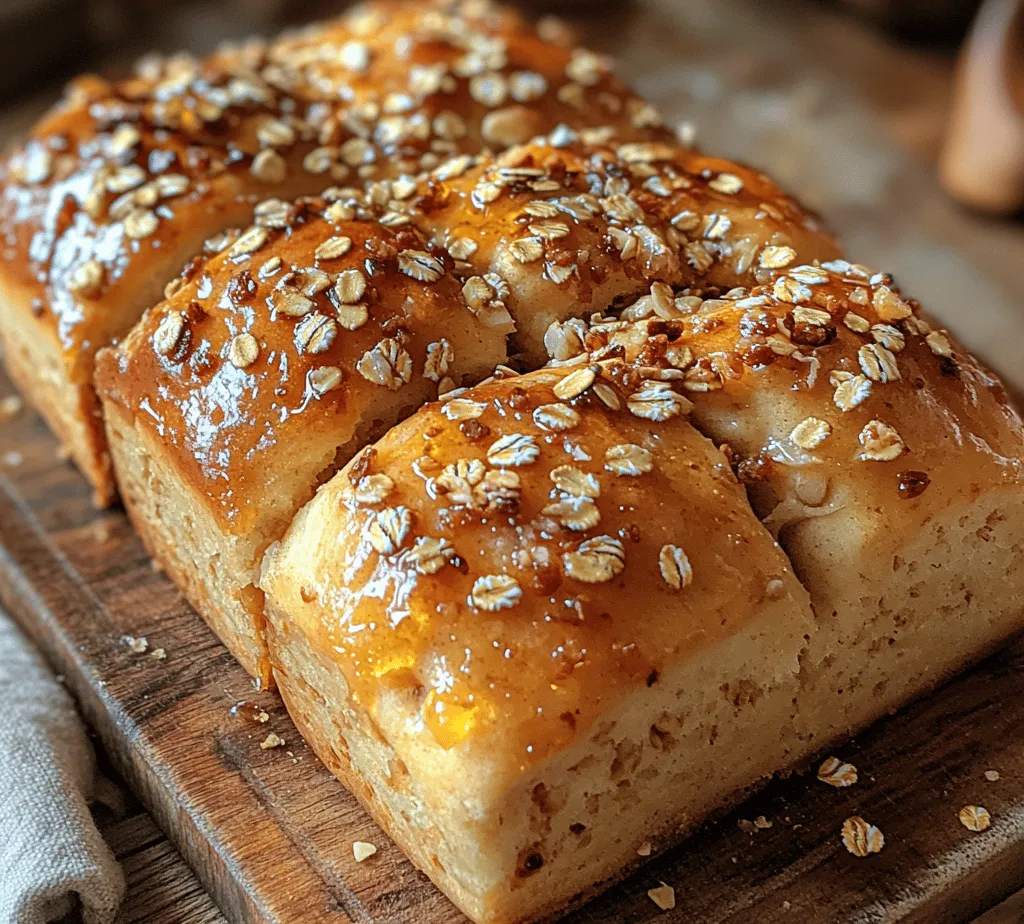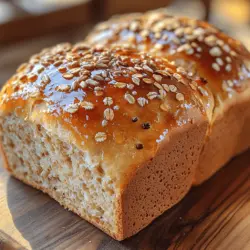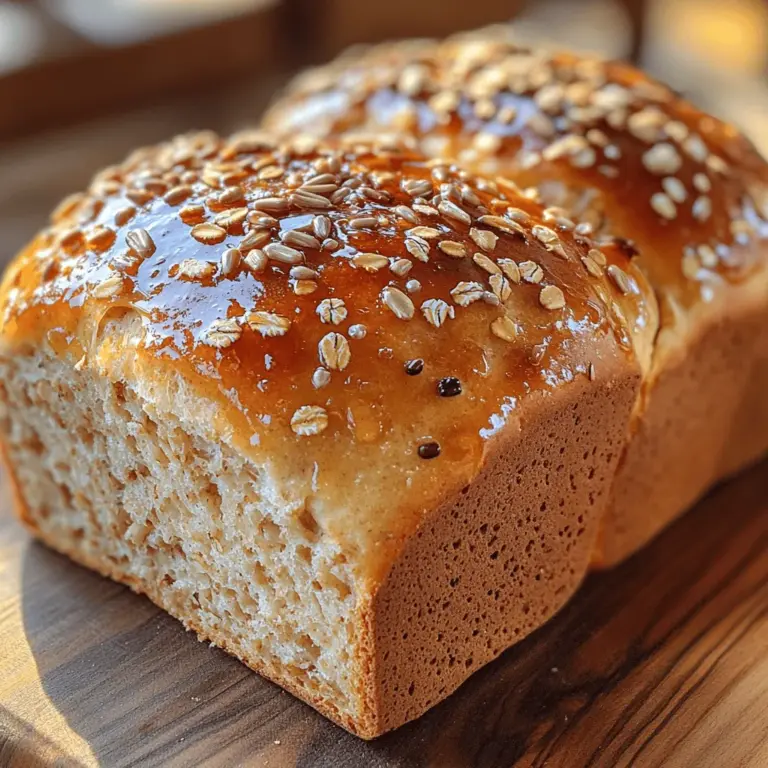Introduction
Baking bread at home is not just about making a meal; it’s an experience that fills your kitchen with warmth and delightful aromas, transforming your space into a cozy haven. Among the myriad of bread recipes out there, Heavenly Honey Oat Bread stands out as a wholesome and naturally sweetened option. This delightful loaf marries the nutty flavor of whole wheat flour with the comforting essence of honey and oats, creating a nutritious and delicious bread that can elevate any meal or snack time.
Imagine slicing into a warm loaf, revealing its golden crust and soft, fluffy interior, while the sweet scent of honey wafts through the air. Whether you’re an experienced baker or just starting your culinary journey, this guide will provide you with everything you need to know to create this delicious bread from scratch. With clear, step-by-step instructions and helpful insights, you’ll be well on your way to mastering the art of homemade bread.
Understanding the Ingredients
To successfully bake Heavenly Honey Oat Bread, it’s essential to understand the key ingredients that contribute to its unique flavor and texture. Each component plays a crucial role in creating a loaf that is both satisfying and nutritious.
Whole Wheat Flour: The Foundation of Your Bread
Whole wheat flour is the backbone of this bread recipe. Unlike all-purpose flour, which is highly refined, whole wheat flour retains the bran and germ of the wheat kernel, offering a richer nutrient profile and a heartier texture.
Nutritional Benefits: Whole wheat flour is high in dietary fiber, which is essential for digestive health. It also contains vital nutrients such as B vitamins, iron, magnesium, and antioxidants that are often stripped away during the refining process. This makes it a healthier choice for baking, as it not only enhances the flavor of your bread but also adds significant nutritional value.
Differences Between Whole Wheat and All-Purpose Flour: When using whole wheat flour, keep in mind that it absorbs more liquid than all-purpose flour due to its higher fiber content. This means that you may need to adjust the amount of liquid in your recipe slightly. Whole wheat flour also produces a denser loaf, which is why the combination with oats and honey is so perfect in this recipe.
Rolled Oats: Adding Texture and Flavor
Rolled oats are another essential ingredient in Heavenly Honey Oat Bread, adding both texture and flavor to the final loaf.
Health Benefits of Oats in Bread: Oats are a fantastic source of soluble fiber, which can help lower cholesterol levels and stabilize blood sugar. They are also rich in vitamins and minerals, making them an excellent addition to any baked good. When added to bread, oats provide a delightful chewiness and contribute to the overall nutritional profile.
How Oats Contribute to the Texture of the Loaf: The inclusion of rolled oats helps to create a moist and tender crumb. As the bread bakes, the oats absorb some of the moisture, resulting in a loaf that stays fresh longer. They also add a rustic charm, making each slice visually appealing and full of character.
Honey: Nature’s Sweetener
Honey is not just a sweetener; it plays a crucial role in enhancing the flavor and moisture of your bread.
The Role of Honey in Flavor and Moisture: Honey adds a natural sweetness that pairs wonderfully with the nuttiness of whole wheat and the earthiness of oats. It also acts as a humectant, meaning it helps retain moisture in the bread, resulting in a soft, tender texture. The subtle floral notes of honey can elevate the overall flavor profile, making each bite a delightful experience.
Potential Substitutions for Honey: If you’re looking for alternatives, maple syrup or agave nectar can be used as substitutes for honey. Keep in mind that these alternatives may alter the flavor slightly, but they can still provide the necessary sweetness and moisture.
Active Dry Yeast: The Leavening Agent
Yeast is the magical ingredient that makes bread rise, creating that light and airy texture we all love.
How Yeast Works in Bread-Making: Active dry yeast ferments the sugars in the dough, producing carbon dioxide gas that causes the dough to expand. This fermentation process not only helps the bread rise but also develops complex flavors through the formation of organic acids.
Tips for Ensuring Your Yeast is Active: Before adding yeast to your dough, it’s crucial to activate it properly. Use warm water (about 110°F or 43°C) to dissolve the yeast and a pinch of sugar to feed it. Let it sit for about 5-10 minutes until it becomes frothy. If it doesn’t foam, your yeast may be expired, and you’ll need to start over with fresh yeast.
Olive Oil and Applesauce: Enhancing Moisture and Flavor
Both olive oil and applesauce are included in this recipe to enhance moisture and flavor.
The Benefits of Using Olive Oil in Bread: Olive oil not only adds richness to the bread but also contributes to its shelf life. It helps to keep the crumb moist and tender, while also providing a subtle fruity flavor that complements the other ingredients.
The Role of Applesauce as a Natural Sweetener and Moisture Booster: Unsweetened applesauce acts as a natural sweetener while adding moisture without the need for additional sugars. It can also help reduce the fat content of your bread, making it a healthier option without sacrificing flavor or texture.
Optional Ingredients: Sunflower Seeds
For those looking to add a bit of crunch and additional nutrition to their Heavenly Honey Oat Bread, sunflower seeds are an excellent choice.
Nutritional Benefits of Sunflower Seeds: These seeds are packed with healthy fats, protein, and vitamins, particularly vitamin E and B vitamins. They also provide a delightful crunch that contrasts beautifully with the softness of the bread.
Creative Toppings for Added Flavor and Texture: Besides sunflower seeds, you can experiment with other toppings such as pumpkin seeds, sesame seeds, or even a sprinkle of oats on top before baking. These additions not only enhance the flavor but also make your bread visually appealing.
Step-by-Step Baking Process
Now that you understand the essential ingredients that will create your Heavenly Honey Oat Bread, it’s time to dive into the baking process. Each step is crucial to ensure that your bread turns out perfectly.
Activating the Yeast: The First Step to Success
The first step in your bread-making journey is to activate the yeast, which is essential for achieving that light, airy texture.
Importance of Using Warm Water: When activating yeast, it’s vital to use warm water—not too hot, as it can kill the yeast, and not too cold, as it won’t activate it. The ideal temperature is around 110°F (43°C).
How to Check if Your Yeast is Active: After dissolving the yeast in warm water with a little sugar, wait for about 5-10 minutes. You should see a frothy layer on top, which indicates that the yeast is active and ready to be mixed with the other ingredients. If there’s no froth, it’s best to start over with fresh yeast.
Mixing the Dry Ingredients: Creating the Base
Once your yeast is activated, it’s time to prepare the dry ingredients, which form the base of your bread.
The Importance of Whisking Flour and Oats Thoroughly: In a large mixing bowl, combine your whole wheat flour and rolled oats. Whisk these dry ingredients together to ensure they are well mixed and to break up any clumps that may have formed. This step is important as it ensures an even distribution of ingredients throughout the dough.
Tips for Achieving the Right Consistency: When measuring flour, it’s essential to spoon it into your measuring cup and level it off with a knife, rather than scooping directly from the bag. This method prevents packing the flour, which can lead to a dense loaf. The final mixture should be slightly grainy with visible oats, creating a hearty texture for your bread.
Combining Wet Ingredients: Bringing It All Together
With your dry ingredients ready, it’s time to combine them with the wet ingredients to form your dough.
How to Properly Mix the Activated Yeast with Oils and Applesauce: In a separate bowl, mix the activated yeast mixture with olive oil and applesauce. Stir well to combine these ingredients before adding them to the dry mixture. This ensures that the wet ingredients are evenly distributed throughout the dough, leading to a consistent flavor and texture.
Importance of Mixing Well for a Uniform Dough: Once you combine the wet and dry ingredients, use a wooden spoon or spatula to mix until a shaggy dough forms. This dough should not be overly sticky; if it is, you can sprinkle a little more flour until you reach the desired consistency.
Forming the Dough: The Art of Bread-Making
The final step in this part of the process is to form the dough, an essential stage in bread-making that requires a gentle touch.
Techniques for Mixing and Forming a Shaggy Dough: After mixing, turn the dough out onto a lightly floured surface. Use your hands to knead the dough gently, folding and pressing it over itself. You want to develop the gluten without overworking the dough. Knead for about 8-10 minutes until the dough is smooth and elastic. Remember, the more you knead, the better the texture of your bread will be.
At this stage, you should have a shaggy, cohesive dough that feels slightly tacky but not overly sticky. If your dough is too wet, sprinkle a little more flour as needed. Once you have achieved the right consistency, you’re ready to let your dough rise and continue the bread-making journey.
Stay tuned for the next part of this article where we will guide you through the rising, shaping, and baking processes to complete your Heavenly Honey Oat Bread. With patience and practice, you’ll be rewarded with a loaf that’s both delicious and nutritious, perfect for sharing with family and friends or enjoying all on your own.



